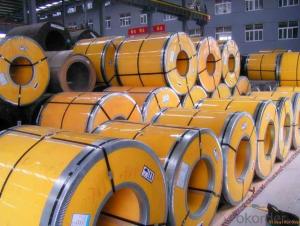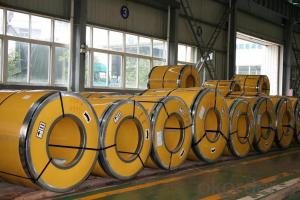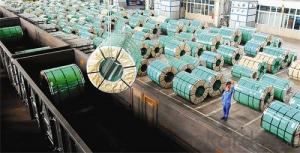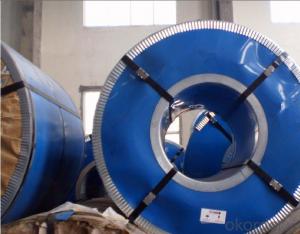Stainless Steel Strip 304 Cold Rolled 2B Finish
- Loading Port:
- Ningbo
- Payment Terms:
- TT OR LC
- Min Order Qty:
- 100 m.t.
- Supply Capability:
- 20000 m.t./month
OKorder Service Pledge
Quality Product, Order Online Tracking, Timely Delivery
OKorder Financial Service
Credit Rating, Credit Services, Credit Purchasing
You Might Also Like
Cold Rolled Stainless Steel Coil 304 Grade 2B Finish
Packaging Detail: standard export packing or as customer's requirements
Delivery Detail: 7-15 days after the order
Standard: | AISI,ASTM,BS,DIN,GB,JIS | Grade: | 304 | Thickness: | 0.3-3.0mm |
Place of Origin: | China Mainland | Brand Name: | CNBM | Model Number: | 304 |
Type: | Steel Coil | Technique: | Cold Rolled | Surface Treatment: | 2B, BA |
Application: | Medical instruments, building, chemical food industry agriculture | Width: | 500-2000mm | Length: | Coil |
finish: | 2B, BA | item: | 304 cold rolled stainless steel coil | density: | 7.93 |
- Q:Can stainless steel strips be customized according to specific requirements?
- Certainly! Stainless steel strips have the capability to be personalized in accordance with specific needs. Stainless steel, being a flexible material, can be easily molded, trimmed, and modified into diverse forms and dimensions. This permits customization to fulfill particular requirements, including width, thickness, length, and surface quality. Furthermore, stainless steel strips can undergo additional customization through techniques such as slitting, edge treatment, and surface refinement to enhance their functionality and aesthetics. Regardless of whether it is for industrial, architectural, or decorative purposes, stainless steel strips can be meticulously tailored to precisely match the specifications and demands of a specific application.
- Q:Can stainless steel strips be used in the energy sector?
- Yes, stainless steel strips can be used in the energy sector. Stainless steel is known for its durability, corrosion resistance, and high strength-to-weight ratio, making it suitable for various applications in the energy sector. It is commonly used in the construction of power plants, oil and gas pipelines, renewable energy infrastructure, and nuclear power plants. Stainless steel strips can be used for electrical transmission, heat exchangers, and other components that require resistance to extreme temperatures and harsh environments.
- Q:Can stainless steel strips be customized in size?
- Indeed, size customization is possible for stainless steel strips. While these strips are commonly found in standard sizes, they can also be tailored to fulfill specific needs. By customizing the size, one gains enhanced adaptability for a wide range of applications. This enables the strips to perfectly match desired dimensions or unique design specifications. The resizing process, which may involve cutting, shearing, or slitting, allows for the achievement of these desired dimensions.
- Q:What are the common surface treatments for stainless steel strips?
- There are several common surface treatments used for stainless steel strips to enhance their appearance, durability, and corrosion resistance. These treatments include: 1. Passivation: This process involves the removal of iron from the surface of stainless steel through chemical treatment. It helps to improve the corrosion resistance by creating a protective oxide layer on the surface. 2. Pickling: Pickling is a chemical treatment that removes impurities, scale, and oxides from the surface of stainless steel. It results in a clean, smooth, and uniform finish. 3. Electropolishing: Electropolishing is an electrochemical process that removes a thin layer of surface material to improve the smoothness and shine of stainless steel. It also helps to reduce the risk of contamination and enhances corrosion resistance. 4. Brushing: Brushing is a mechanical surface treatment that involves using abrasive brushes to create a textured or satin finish on stainless steel. It can help to hide scratches and provide a decorative appearance. 5. Grinding: Grinding is another mechanical treatment that uses abrasive wheels to remove surface imperfections and create a smooth, polished finish on stainless steel. 6. Coating: Coating stainless steel strips with protective films or paints can provide an added layer of protection against corrosion, scratches, and other damages. These coatings can be clear or colored, depending on the desired aesthetic. It is important to select the appropriate surface treatment based on the desired outcome and the specific requirements of the application. Each treatment offers distinct benefits and can significantly enhance the performance and aesthetics of stainless steel strips.
- Q:Are stainless steel strips resistant to humidity?
- Yes, stainless steel strips are highly resistant to humidity. They have a high level of corrosion resistance and do not easily rust or tarnish when exposed to moisture or high humidity environments.
- Q:Can stainless steel strips be used in the production of automotive parts?
- Stainless steel strips possess the capability to be utilized in the manufacturing of automotive components. Stainless steel, being an incredibly versatile material, offers remarkable strength, durability, and resistance against corrosion, rendering it suitable for a diverse range of automotive applications. The utilization of stainless steel strips enables the production of a wide array of automotive parts, encompassing body panels, trim, exhaust systems, brackets, and reinforcements. The remarkable strength-to-weight ratio of stainless steel facilitates the creation of lightweight automotive components without compromising their strength and performance. Furthermore, the resistance of stainless steel to rust and corrosion guarantees that automotive parts crafted from this material exhibit exceptional durability and can endure harsh environmental conditions, such as exposure to moisture, road salt, and chemicals.
- Q:How do stainless steel strips perform in coastal environments?
- Stainless steel strips perform exceptionally well in coastal environments due to their inherent corrosion resistance properties. The presence of saltwater and high humidity levels in coastal areas can cause conventional metals to corrode quickly, but stainless steel resists rust and corrosion, making it ideal for coastal applications. Its chromium content forms a protective oxide layer on the surface that prevents oxidation and provides long-term durability. This resistance to corrosion makes stainless steel strips a reliable choice for various coastal applications, including construction, marine equipment, and coastal infrastructure.
- Q:Can stainless steel strips be used in water distribution systems?
- Yes, stainless steel strips can be used in water distribution systems. Stainless steel is highly resistant to corrosion and can withstand the harsh conditions and chemicals commonly found in water distribution systems. It is a durable and reliable material choice for ensuring the longevity and safety of water infrastructure.
- Q:Are stainless steel strips suitable for high-temperature exhaust systems?
- Yes, stainless steel strips are suitable for high-temperature exhaust systems. Stainless steel is a corrosion-resistant and heat-resistant material that maintains its strength and integrity at high temperatures. It has excellent oxidation resistance, making it ideal for applications where the exhaust gases reach elevated temperatures. Stainless steel strips can withstand the extreme heat generated by exhaust systems, ensuring durability and reliability. Additionally, stainless steel's resistance to corrosion and rust allows it to withstand the harsh conditions and corrosive elements present in exhaust systems. Overall, stainless steel strips are a suitable choice for high-temperature exhaust systems due to their heat resistance, durability, and corrosion resistance properties.
- Q:How do stainless steel strips handle exposure to alkalis?
- Due to their strong resistance to alkalis, stainless steel strips are an ideal choice for applications that require exposure to such substances. The presence of chromium in stainless steel creates a protective layer on the surface, called a passive film, which acts as a barrier against corrosion and chemical attacks. This passive film effectively blocks alkalis from penetrating the steel, thereby safeguarding it against potential damage. Moreover, stainless steel's exceptional corrosion resistance and durability enable it to withstand prolonged exposure to alkalis without deterioration or loss of structural integrity. As a result, stainless steel strips are a dependable and enduring material for a wide range of industrial and commercial uses that involve alkalis.
1. Manufacturer Overview |
|
|---|---|
| Location | |
| Year Established | |
| Annual Output Value | |
| Main Markets | |
| Company Certifications | |
2. Manufacturer Certificates |
|
|---|---|
| a) Certification Name | |
| Range | |
| Reference | |
| Validity Period | |
3. Manufacturer Capability |
|
|---|---|
| a)Trade Capacity | |
| Nearest Port | |
| Export Percentage | |
| No.of Employees in Trade Department | |
| Language Spoken: | |
| b)Factory Information | |
| Factory Size: | |
| No. of Production Lines | |
| Contract Manufacturing | |
| Product Price Range | |
Send your message to us
Stainless Steel Strip 304 Cold Rolled 2B Finish
- Loading Port:
- Ningbo
- Payment Terms:
- TT OR LC
- Min Order Qty:
- 100 m.t.
- Supply Capability:
- 20000 m.t./month
OKorder Service Pledge
Quality Product, Order Online Tracking, Timely Delivery
OKorder Financial Service
Credit Rating, Credit Services, Credit Purchasing
Similar products
New products
Hot products
Related keywords





























